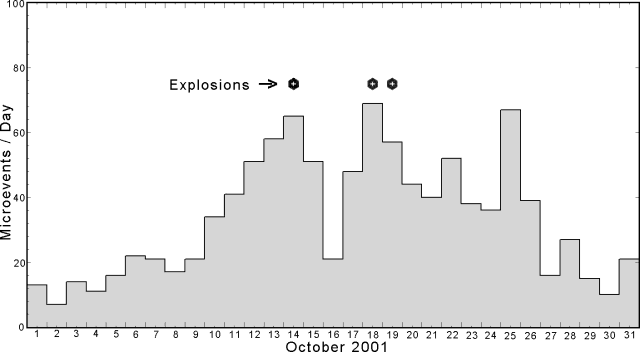Report on Colima (Mexico) — October 2001
Bulletin of the Global Volcanism Network, vol. 26, no. 10 (October 2001)
Managing Editor: Richard Wunderman.
Colima (Mexico) Lava dome extrusion in May and October 2001
Please cite this report as:
Global Volcanism Program, 2001. Report on Colima (Mexico) (Wunderman, R., ed.). Bulletin of the Global Volcanism Network, 26:10. Smithsonian Institution. https://doi.org/10.5479/si.GVP.BGVN200110-341040
Colima
Mexico
19.514°N, 103.62°W; summit elev. 3850 m
All times are local (unless otherwise noted)
An explosive eruption on 10 February 1999 (BGVN 24:01) marked the end of the block-lava emission that started on 20 November 1998 (BGVN 23:11). Other explosive events followed on 10 February, 10 May, 17 and 29 July 1999, and on 22 February 2001. Seismic precursors occurred just before the explosions and were of small magnitude, making it difficult to warn civil defense authorities.
A new dome appeared in May 2001 (BGVN 26:05). During August, a reconnaissance flight was carried out by Suárez-Plascencia and Núñez-Cornú, who observed in the main crater a steep-sided mound (scoria cone) and an inner crater. Fumarolic activity occurred in small explosion pits on the top and the walls of the scoria cone.
Figure 44 shows that seismicity continued at a low level through early October. On 1 October, small discrete earthquakes, called "pulgas" (fleas), began to appear at a rate of one or more per hour. Not seen since November 1998, these pulgas were previously associated with magmatic extrusions. Seismicity increased until 14 October, and then underwent several cycles of increase and decrease, again reaching previous low levels by the end of the month. During these dates, no visual observations of the crater were possible due to continuous cloud cover.
 |
Figure 44. Histogram of seismic events at Colima during October 2001. Explosions are indicated by stars. Courtesy of Centro de Sismologia y Volcanología de Occidente. |
On the morning of 31 October from Bravo Nectar (Nevado Base, 900 m NW of summit of Nevado de Colima), members of Protección Civil Jalisco observed a "needle" or spine over the main crater rim. Jalisco authorities who carried out a flight to observe changes in the crater discovered a new dome with a spiny surface that had grown over the 22 February explosion crater (figure 45). New explosion pits were observed on the scoria cone. Later photos show the evolution of the two features seen on 4 August. First, on 31 October the scoria cone contained new explosion pits. Second, the inner crater became the site of a new dome. This dome contained a conspicuous spine (figure 45). Compared to the 120-m-radius crater, the spine had a radius of ~20 m and was ~60 m high. This implies the spine's volume was ~75,000 m3.
Other photos taken on 10 November revealed a cracking of the dome's spiny crown as a result of a widening of the dome, maybe due to a very low input of plastic material. These facts suggest that extrusion of this new structure began in early October and continued with a high growth rate, reaching a maximum on 14 October. The spiny extrusion probably occurred around this day and was accompanied by small explosions. Seismicity decreased beginning on 18 October, which suggests a corresponding decrease in the extrusion rate. By 4 November seismicity reached background levels, perhaps implying aseismic dome growth. This could be due to a decrease in the extrusion rate or to the cooling of the dome, which began to act as a cork, a behavior that implies a more hazardous scenario.
This extrusion may herald a new, more dangerous stage in the eruptive process of the volcano, analogous with a Pelean dome. It may portend more energetic explosions, larger pyroclastic flows, dome collapse events, and substantial lahars. These observations suggest that at the moment there are two active vents inside the crater, as in the 1991 episode (Núñez-Cornú and Sanchez, 1998); one vent is on the N side and the other is on the W side. The spine grew in the N vent, while the W vent featured small explosions throwing ashes and scoria.
Geological Summary. The Colima complex is the most prominent volcanic center of the western Mexican Volcanic Belt. It consists of two southward-younging volcanoes, Nevado de Colima (the high point of the complex) on the north and the historically active Volcán de Colima at the south. A group of late-Pleistocene cinder cones is located on the floor of the Colima graben west and east of the complex. Volcán de Colima (also known as Volcán Fuego) is a youthful stratovolcano constructed within a 5-km-wide scarp, breached to the south, that has been the source of large debris avalanches. Major slope failures have occurred repeatedly from both the Nevado and Colima cones, producing thick debris-avalanche deposits on three sides of the complex. Frequent recorded eruptions date back to the 16th century. Occasional major explosive eruptions have destroyed the summit (most recently in 1913) and left a deep, steep-sided crater that was slowly refilled and then overtopped by lava dome growth.
Information Contacts: F. Núñez-Cornú and C. Suárez-Plascencia, Centro de Sismologia y Volcanologia, Centro Universitario de la Costa, Av. Universidad 203, Del. Ixtapa, Puerto Vallarta, Jalisco, Mexico; G. Reyes-Dávila, RESCO, Univ. de Colima, Apartado Postal 2-1694, 28000 Colima, Mexico.


